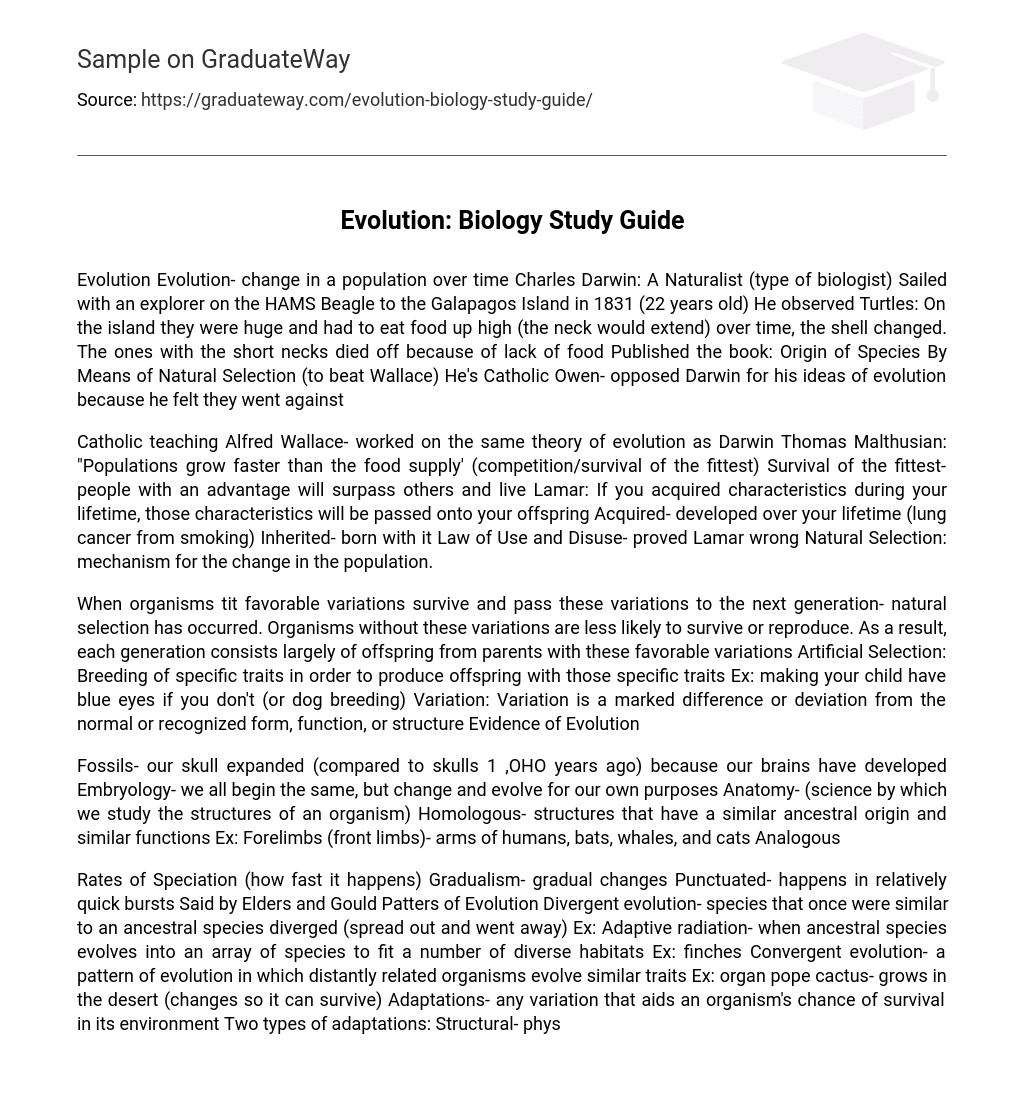Evolution Evolution- change in a population over time Charles Darwin: A Naturalist (type of biologist) Sailed with an explorer on the HAMS Beagle to the Galapagos Island in 1831 (22 years old) He observed Turtles: On the island they were huge and had to eat food up high (the neck would extend) over time, the shell changed. The ones with the short necks died off because of lack of food Published the book: Origin of Species By Means of Natural Selection (to beat Wallace) He’s Catholic Owen- opposed Darwin for his ideas of evolution because he felt they went against
Catholic teaching Alfred Wallace- worked on the same theory of evolution as Darwin Thomas Malthusian: “Populations grow faster than the food supply’ (competition/survival of the fittest) Survival of the fittest- people with an advantage will surpass others and live Lamar: If you acquired characteristics during your lifetime, those characteristics will be passed onto your offspring Acquired- developed over your lifetime (lung cancer from smoking) Inherited- born with it Law of Use and Disuse- proved Lamar wrong Natural Selection: mechanism for the change in the population.
When organisms tit favorable variations survive and pass these variations to the next generation- natural selection has occurred. Organisms without these variations are less likely to survive or reproduce. As a result, each generation consists largely of offspring from parents with these favorable variations Artificial Selection: Breeding of specific traits in order to produce offspring with those specific traits Ex: making your child have blue eyes if you don’t (or dog breeding) Variation: Variation is a marked difference or deviation from the normal or recognized form, function, or structure Evidence of Evolution
Fossils- our skull expanded (compared to skulls 1 ,OHO years ago) because our brains have developed Embryology- we all begin the same, but change and evolve for our own purposes Anatomy- (science by which we study the structures of an organism) Homologous- structures that have a similar ancestral origin and similar functions Ex: Forelimbs (front limbs)- arms of humans, bats, whales, and cats Analogous
Rates of Speciation (how fast it happens) Gradualism- gradual changes Punctuated- happens in relatively quick bursts Said by Elders and Gould Patters of Evolution Divergent evolution- species that once were similar to an ancestral species diverged (spread out and went away) Ex: Adaptive radiation- when ancestral species evolves into an array of species to fit a number of diverse habitats Ex: finches Convergent evolution- a pattern of evolution in which distantly related organisms evolve similar traits Ex: organ pope cactus- grows in the desert (changes so it can survive) Adaptations- any variation that aids an organism’s chance of survival in its environment Two types of adaptations: Structural- physically see Changes in the anatomy Ex: mole rat- long claws and sharp teeth to make up for it being blind Mimicry- an organism tries to be like another more dangerous organism Camouflage- blends in with its surroundings Physiological- internal environment Ex: bacteria- by making different proteins it has adapted to the medicine we’ve developed to kill off their species Fill Ins List the 3 different types of Natural Selection?
Give an example of each 1. Example: 3. What are the 2 patterns of evolution? Give an example 2. What are the possible causes of speciation? Give an example of each cause 1 . What are the two theories regarding the rate of speciation? What are the two main categories of adaptation? What are the two types of structural adaptation. Give an example 1 . Give an example of physiologic adaptation Name 3 different species Darwin studied on the Galapagos? Describe any interesting facts 1. Fact: Answer Key List the 3 different types of Natural Selection? Give an example of each Stabilizing selection Example: a population of spiders in which average size is a survival advantage.
Directional selection Example: wood peckers feeding on insects deep within the tree bark- birds with long beaks have an advantage over short or average size beaked Disruptive selection Example: white-shelled limpets cannot be seen on light rocks, dark colored limpets camouflage with the dark rocks, tan-colored limpets can be seen on either the light or dark backgrounds. Divergent evolution Example: (adaptive radiation, when ancestral species evolves into an array of species to fit a number of diverse habitats) An example of that would be the finches. Government evolution Example: organ pope cactus. What are the possible causes of speciation? Give an example of each cause Geographical Isolation Example: If small populations of tree frogs were geographically isolated, they would no longer be able to interbreed and exchange genes.
Reproductive isolation Example: if one population of tree frogs mates in the fall, and another mates in the summer Chromosomal isolation Example: When a Polyploidy mates with an individual of the normal species, the offspring will not develop normally because of difference in chromosome numbers Gradualism Punctuated What are the Structural Physiological two main categories tot adapt action? What are the two types of structural adaptation. Give an example Mimicry Example: yellow Jacket wasp and a harmless surprised fly- the colors and body shape are similar, so predators avoid both. Camouflage Example: leaf frog Bacteria- by making different proteins it has adapted to the medicine we’ve facts Beak of the Galapagos finches Fact: They have adapted to feed on cacti Tortoises Fact: largest on Earth, differing from other tortoises in body size and shape Marine iguanas Fact: ate algae from the ocean, an unusual food source for reptiles. Large claws help them cling to slippery rocks.





